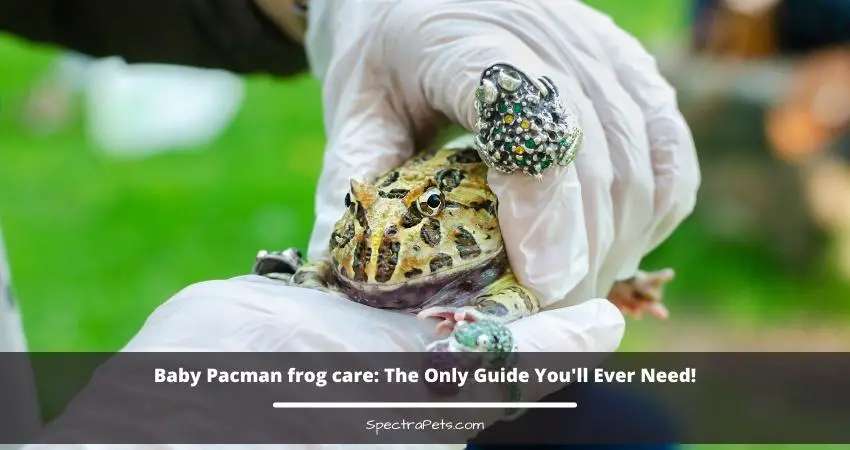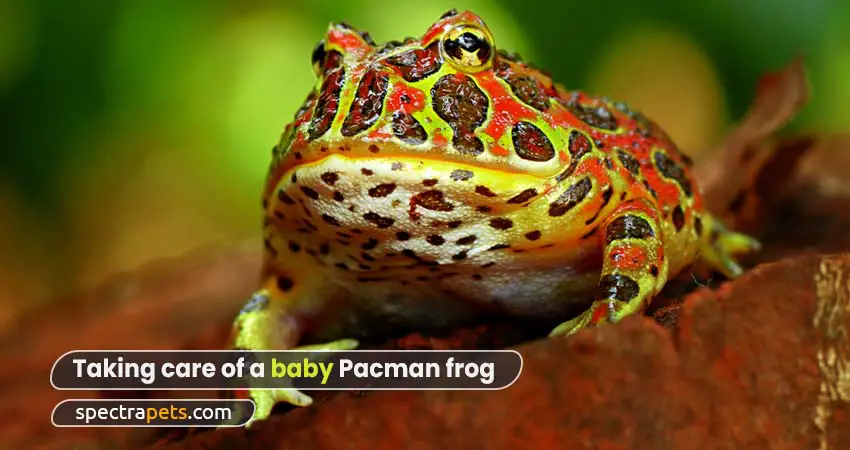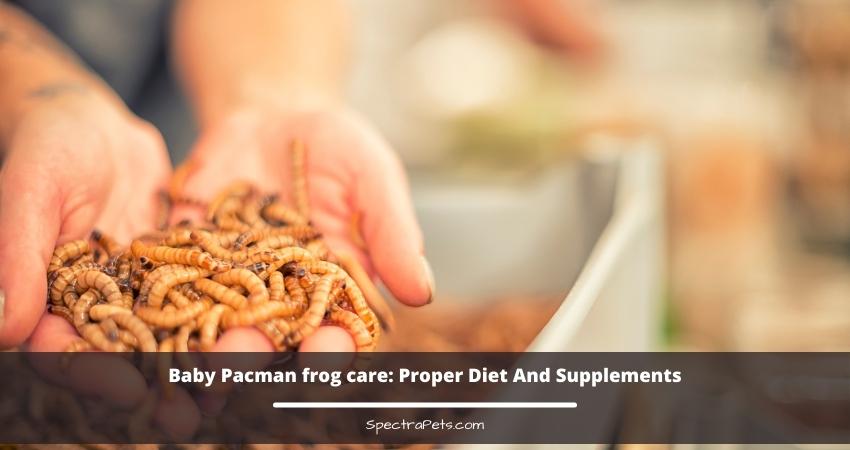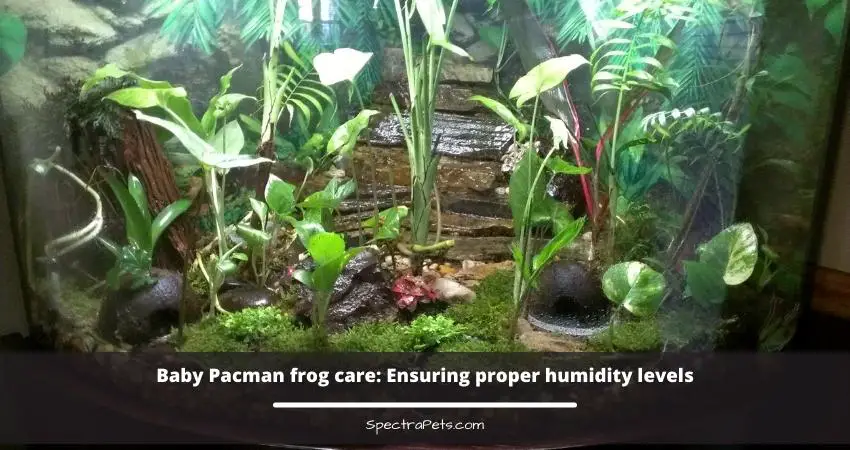Among people who want frogs as pets, Pacman frogs are very popular. Their popularity can be attributed to their unique look, inactive nature, and hardiness. Sometimes people bring baby Pacman frogs home instead of the matured ones. But they don’t know the details about baby Pacman frog care.
Baby Pacman frogs are a little bit more fragile than the adult ones like all babies are. They need proper housing, diet, humidity, and temperature to be perfectly healthy. Other factors include the nature of the substrates, tank decoration, and various supplements. The factors mentioned above play an equally important role in a Pacman frog’s growth and development.
Let’s take a detailed look at how to take care of a baby Pacman frog.

Taking care of a baby Pacman frog
Babies need special care, no matter what their species is. Pacman frogs are no exception to this. So if you have a baby frog and want to take care of it properly, take a look below:
1. Ensuring Proper Housing
When you first bring home a little Pacman frog pup, you have to ensure it is housed properly. This takes the most precedence, even before the diet of the frog. Usually, a baby frog can be housed in a little plastic tank. But this is temporary as Pacman frogs grow quite fast and they’ll soon outgrow this tank.
So it’s better to place the baby frog into the tank you’d eventually put it in when it would’ve grown up. The ideal size of a Pacman frog enclosure should be between 10 to 20 gallons. A female Pacman frog needs double the space of a male one. So it’s best if you prepare a 20-gallon tank beforehand since it’s impossible to determine their gender before they are mature.
It has to be kept in mind that baby Pacman frogs should never be kept in a group. Pacman frogs are voracious eaters which will eat even a member of their species. So it’s a bad idea to put more than one baby frog in one tank.
2. Providing A Proper Diet: Foods And Supplements
A proper diet is a part and parcel of the growing-up process of a baby Pacman frog. The diet of a baby frog consists of a couple of things, regular food, and supplements.
Adult Pacman frogs eat anything within their size range and range of attack, including other Pacman frogs. But the range of food has to be dialed down a little when it comes to the babies. Yes, you can feed it worms and insects like the adults, but when it comes to feeding them mice, wait until they are fully grown. Mice will pose too much of a challenge to the baby frogs which are no larger than a coin, and may eventually end up eating them.

Now, as far as supplements go, these frogs need plenty of vitamin D as well as calcium. These two are needed for the proper development of skeletal tissue. A strong skeleton makes sure the frogs aren’t prone to diseases such as Metabolic Bone Disease. Dusting all the food with calcium and vitamin D is a good way to provide the babies with the boost they need.
Feeding frequency is also very important while the baby frogs are growing up. Baby Pacman frogs are more voracious than adult ones when it comes to how often they need to be fed. You will need to feed them daily to ensure proper growth. Sometimes the babies eat once every two days, which isn’t a warning sign.
Another important aspect is the amount of food that has to be fed to a baby Pacman frog. There is an easy way to find out how much food you need to put in the tank. Once a frog has eaten its fill, it will not touch any food until it becomes hungry again. But make sure the uneaten food is removed as soon as possible.
The last factor regarding a baby Pacman frog’s diet is when you should feed it. Pacman frogs are nocturnal creatures, so they are most active at night. So it’s best to feed them at night. Just leave the food inside the tank throughout the night and remove the uneaten ones in the morning.

3. Ensuring proper humidity levels
Once the diet of the baby Pacman frog has been sorted out, it’s time to ensure the frog has proper living conditions inside the tank. Pacman frogs come from humid environments, so the tank’s inside must be equally humid.
The ideal humidity range of a Pacman frog tank is 60 to 80 percent. It’s a must that the humidity does not fall below the 60% mark.
But how do you ensure the proper humidity levels for a baby Pacman? First, you need to mist the frog’s tank twice a day. Second, you can keep a water bowl filled with fresh and clean water. But make sure the bowl is shallow. Third, make sure the substrates, decorations, and bedding are absorbed.
The next thing you can do to ensure proper humidity levels is to use a fogging device. Lastly, having a humidifier in the room where the frog’s tank is situated is a good way to make sure the humidity level is perfect.

4. Making sure the heat and light are perfect
Another thing that has to be spot on to help a baby Pacman frog thrive, is the heat and lighting in the tank.
Despite being nocturnal animals, Pacman frogs, especially babies, need a specific amount of heat and light in the tank. The bulb that is being used should not be a UV or a sunlight bulb, that’s the only condition of lighting a Pacman frog tank. The tank should have a light and dark period of twelve hours each.
When it comes to temperatures, Pacman frogs’ natural habitat is moderately warm forests. So their babies need similar temperatures in their tanks to live.
The day temperature of a baby Pacman frog tank should be between 25 to 27.7 degrees Celsius. On the other hand, the night temperature should be a bit cooler, between 21.1 to 23.8 degrees Celsius.
5. Providing proper substrates
Pacman frogs love to burrow in the substrates of their tanks. This is a trait shared by both adults and babies. So the substrates should be as such that their skins aren’t affected by the substances present in them. The substrates you provide must be suitable for burrowing.
Some popular choices for baby Pacman frog tank substrates are Coconut fiber, Coconut husks, Sphagnum moss bedding, leaf litter, tree bark, soil, and mixed substrates.
No matter what substrate you provide, make sure that they can absorb and retain moisture. This will help in the preservation of the humidity levels of the tank. Also, since the baby frogs’ skins are pretty sensitive, the substrates must not have anything sharp in them.
6. Decorating the tank appropriately
The decorations of a baby Pacman frog tank are optional. It’s better if you do it, but you don’t have to decorate the tank. But if you do decide to decorate your baby frog’s tank, it has to be appropriate.
There are plenty of decors you can choose from. You can put anything from leaves and stones to branches and logs in the tank. But keep in mind that first, these things must help the frogs to hide. And these must not have anything that can potentially hurt the frog.
Final Words
Baby Pacman frog care is way harder than obtaining one. There are a lot of things that need to be perfect when you bring a baby Pacman frog home. From their tanks to their food, everything has to be proper to help this little guy thrive and grow into a beautiful adult Pacman frog.
